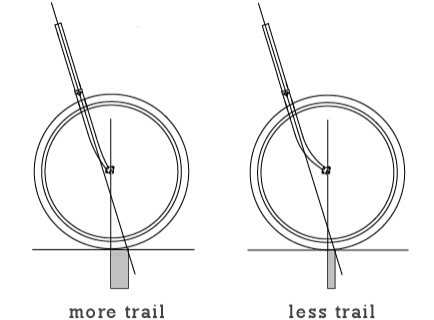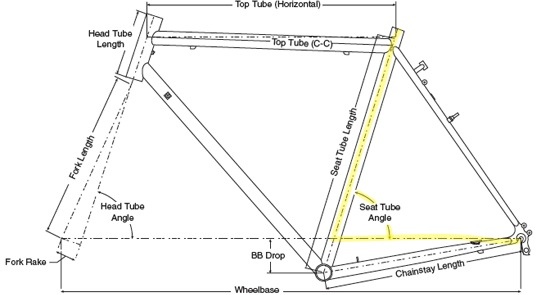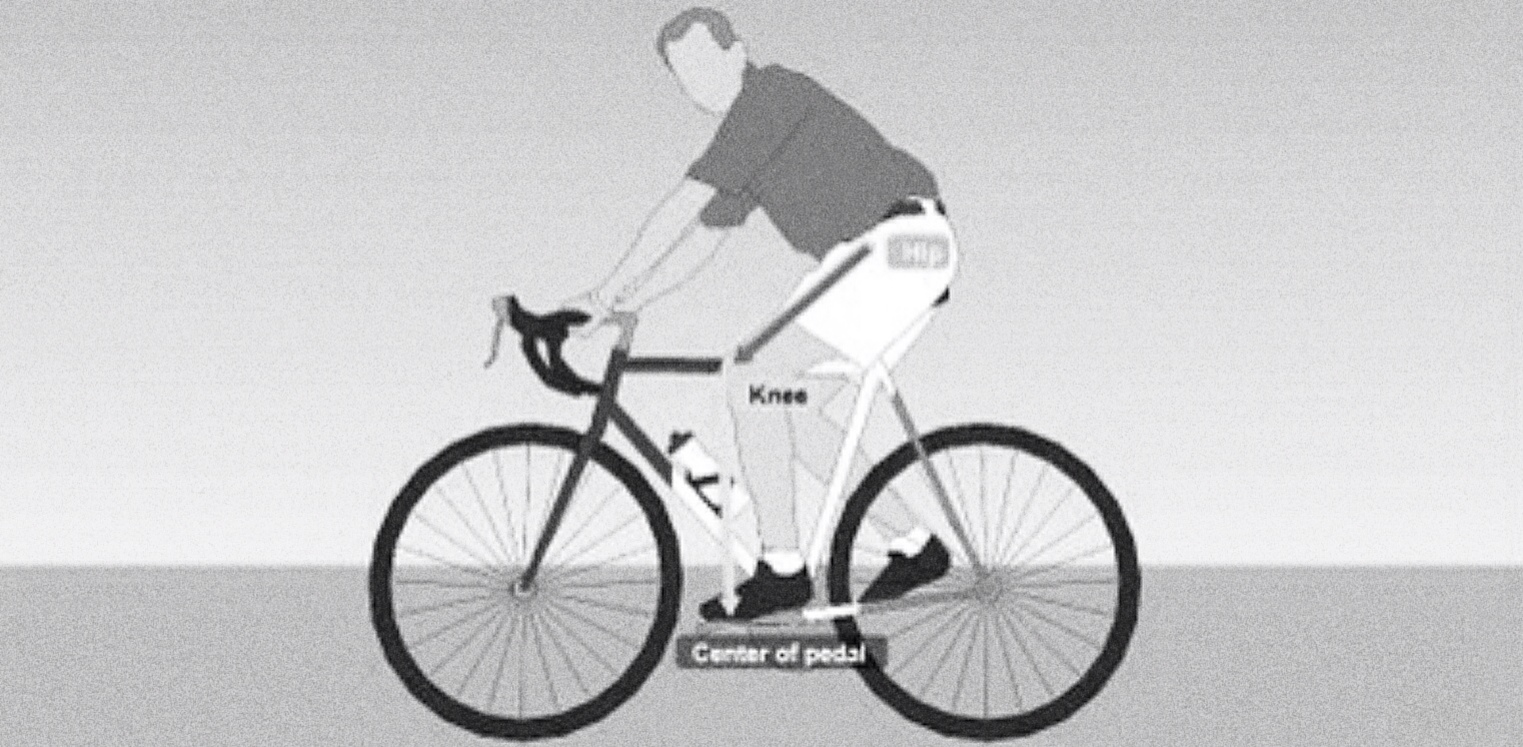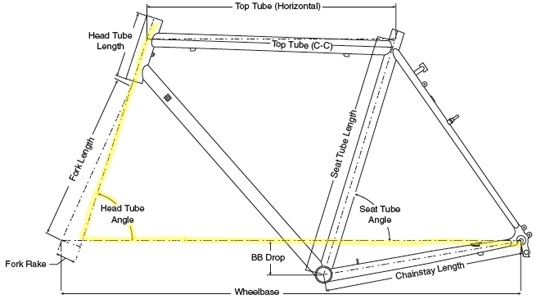Understanding Bicycle Frame Geometry
Understanding Bicycle Frame Geometry
I receive a lot of questions about bicycle frame geometry, so I’ve pieced together this resource to discuss the reasons why bicycle frames are built to the lengths and angles that they are. This information will allow you to look at a geometry chart online, and understand how different bikes will ride without testing them!
It’s important to note that bicycle geometry is different for each bike size, given our varying heights offer different body proportions. At the bottom of each geometry feature, I have incorporated a comparison between a road, cyclocross and touring bike with 57cm top tube length. This should help you understand how changes to geometry suit different cycling disciplines.
Right, let’s get to it!
Understanding the Steering
The front end of the bike is a bit complicated but we can work through it.
There are three measurements at play:
Head Tube Angle
Fork Rake (or Offset)
Fork Trail
Out of the three, Fork Trail arguably tells us the most about how a bicycle will steer. But let’s start with the head tube angle.
Head Tube Angle
The headtube angle is the angle at which the head tube is to the ground.
A bike with a steeper head angle has faster steering. There is less effort required to steer it.
A bike with a slacker head angle has slower steering. There is more effort required to steer it.
Touring bikes use slacker head angles when compared to their road/cx relatives because they generally carry a front load, and a slower steering speed helps with stability when a bike is moving at moderate to high speeds.
Head Tube Angle Comparison for 57cm Bikes:
Touring bikes 71-72 degrees
Road bikes 73-74 degrees
CX 72-73 degrees
Fork Rake (Offset)

Fork rake is the offset of the fork dropout from the straight line of the steering axis (centreline of the fork’s steerer tube).
Increasing the fork rake makes steering faster.
Decreasing the fork rake makes steering slower.
Touring bikes have more rake than road and cyclocross bikes in order to increase their wheelbase length, provide more toe clearance from the front wheel and to increase the fork’s vertical compliance. But hang on… touring bikes have more rake compared to road/cx bikes yet they steer slower? Well, fork rake is only one ingredient in the steering equation. Let’s talk about ‘trail’ to understand the rest.
Fork Rake Comparison for 57cm Bikes:
Touring forks 45-52mm
Road forks 40-45mm
CX forks 45mm.
Fork Trail

The product of the head tube angle and the fork rake is the ‘trail’. This is the measurement that gives us the best indication of how fast a bike will steer. It’s a measurement not often provided by bike manufacturers despite being the most important steering speed information for the handling of the front end.
Less trail equates to faster steering. Making a bike feel more nimble like it’s steered ‘with your hands’.
More trail equates to slower steering. Making a bike feel more stable like it’s steered ‘with your hips’ (leaning).
Touring bikes have a lot of ‘trail’ to slow steering response and keep heavy loads stable on fast descents. On the other hand, high trail bikes experience more ‘wheel flop’ making it harder to keep a straight line at slower speeds (although front panniers tend to dampen this feeling).
In an ideal world, a bike designed to use a wide handlebar (flat, riser, alt bars) will benefit from more ‘trail’ than a bike using road handlebars. This is because wide bars provide a greater steering leverage and therefore require less steering input when turning.
Trail Comparison for 57cm Bikes:
Touring bikes 55-70mm trail
Road bikes 50-60mm trail
CX 55-65mm trail
Steering Summary
A touring bike’s geometry is optimised so that it’s stable carrying front and rear loads. This is evident through the slacker head angles and higher ‘trail’ than both road and cyclocross bikes.
Road bike steering is tuned to be fast with its low trail geometry. This makes sense in a racing situation where you may need to change direction in a split second. On the other hand, cyclocross bike geometry tends to fall somewhere between that of a road and touring bike.
Some randonneur, bikepacking or light touring bikes are designed with less trail than even a road race bike (sub-40mm). The idea is that a quicker steering speed is offset by the heavier steering input of a front load. On a bike with road handlebars using a sub-10kg (22lbs) front load, I tend to really like this design approach. However, I’ve found that low trail bikes ride a bit strange without any front load. They can also be a little harder to handle with heavy front panniers at higher speeds too.
Chainstay Length
One of the more important measurements on a touring bike is the chainstay length. A longer chainstay length is desirable to increase the wheelbase (making the bike more stable at speed) and to provide ample heel clearance from the panniers. Heel clearance is especially important for riders with larger feet (size 11-13 / 46-49) as your feet can sometimes strike the rear panniers when you pedal. That said, there are rear racks that push your panniers further back if you need.
Chainstay Length Comparison for 57cm Bikes:
Touring bike 445-470mm
Road bikes 405-415mm
CX 420-435mm
Wheelbase

A longer wheelbase provides a more stable and comfortable ride. Touring bikes have a long wheelbase due to a combination of a slack head angle, long fork rake and long chainstay length.
Wheelbase Comparison for 57cm Bikes:
Touring bikes 1050-1070mm
Road bikes 996mm
CX 1018mm
Bottom Bracket Drop

Bottom bracket drop determines how high your cranks sit from the ground when you pedal. A lower bottom bracket results in a lower saddle height and therefore a lower centre of gravity.
Touring bikes may need pedal clearance over obstacles, so some manufacturers provide a high bottom bracket (53mm drop with 700c wheels). This is generally offered on off-road touring bikes. Other manufacturers provide a low bottom bracket (78mm drop with 700c wheels) to maximise the stability of the bike, albeit at the risk of pedal strike at times. This is more common with the road-oriented touring bikes.
Seat Tube Angle

Seat tube angles don’t differ a lot between touring and road/cx bikes of the same size. This is because optimal pedalling positions aren’t too different between bikes. That said, there is some variation between touring bikes. The more upright models (taller head tube) will offer a slacker seat tube angle to match your less rotated pelvis.
Seat Tube Angle Comparison for 57cm Bikes:
Touring bikes 71-73 degrees
Road bikes 73 degrees
CX 73 degrees.
A very general bicycle fitting rule (to optimise pedalling efficiency) is to have your knee reach the pedal axle (see diagram). If you were to slacken a seat tube angle, your knee may not reach as far as the pedal axle (and would, therefore, be less efficient, cause knee pain etc). You can see my resource Understanding Bike Fit for more information on optimising your position.
Stack and Reach: Important for Comparing Bikes

Stack and reach measurements are the best information we have to know if a bike will fit us, without test riding it first.
These measurements assess the virtual position of the headtube in relation to the bottom bracket, essentially standardising bike geometry/sizing between brands and models. This is important because bikes from two manufacturers that are both called the same size (eg. medium or 54cm) can actually fit up to 2cm (a full size) different from one another. If the companies you’re looking at don’t have the stack and reach data on their website, here is a virtual calculator.
You can get a professional bicycle fitter to determine your appropriate stack and reach, making it much easier to find a perfectly fitting bike. Alternatively, you can measure up a bike you’re comfortable riding with a tape measure to find out its stack/reach.
Effective Top Tube Length

The effective top tube (ETT) length is the simplest way to determine a bike’s size. That said, just because the ETT is the same between the two bikes, it doesn’t mean the bikes will have the same reach.
Seat Tube Length

Seat tube length isn’t too important for most people with the exception of those who need additional standover clearance (often smaller riders). Again, it’s best to compare bikes based on their stack and reach measurements if you can.
Head Tube Length

Long head tubes are common on touring bikes in order to prop the bars up high without the use of excessive headset spacers. Head tubes are often 40mm+ longer than the equivalent road or cyclocross bike.
Not Using a Front Pannier Rack?
If you’re planning on cycle touring with front OR rear bags only; a touring bicycle frame geometry is arguably less important to you. A mountain bike with rear panniers does not actually ride all that different to a touring bike with rear panniers.
Bicycle frame geometry is particularly important if you’re planning on using front and rear loads as:
– The long wheelbase and long fork rake will provide additional stability and comfort while riding
– The higher ‘trail’ of the front end will help your bike to handle well with a load
– The frame will be built super stiff to handle the twisting forces coming through your bike.【完】




